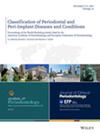Prevalence, incidence, risk, and protective factors for soft tissue dehiscences at implant sites in the absence of disease: An AO/AAP systematic review and meta-regression analysis
Abstract
Background
The aim of the present review was to evaluate the prevalence and incidence of soft tissue dehiscences at implant sites in absence of disease, together with the related risk and protective factors.
Methods
A systematic search was conducted to identify cross-sectional and prospective studies reporting information on soft tissue dehiscences. Mixed-effects uni- and multi-level regression analyses were performed to identify predictive factors associated with these conditions.
Results
A total of 221 eligible studies were included. Soft tissue dehiscences (“recessions”) were identified as peri-implant soft tissue dehiscences (PSTDs), Mucosal level (ML) apical shifts, and mucosal recessions (MRECs). The mean prevalence of PSTD and MREC was 46.2% and 23.1%, respectively. The incidence of PSTD, MREC, and apical shift of ML within 5 years following loading was up to 38.3%, 47.8%, and 23.6%, respectively. Limited mucosal thickness (MT), immediate implant therapy, and lack of peri-implant soft tissue augmentation were risk factors for PSTD, while limited MT, lack of/limited keratinized mucosa (KM) width, and immediate implant therapy were risk factors for ML apical shift. Guided implant surgery, bone grafting at implant placement, soft tissue augmentation, and adequate KM and MT were protective factors for the stability of ML. Lack of/limited KM width and interproximal marginal bone loss were risk factors for MREC.
Conclusions
Soft tissue dehiscences are commonly observed at implant sites. Risk and protective factors associated with PSTD, ML apical shift, and MREC were identified. A new diagnostic system and format for assessing and reporting soft tissue dehiscence at implant sites was proposed.
Plain Language Summary
The aim of the present review was to evaluate the prevalence and incidence of soft tissue recession (“gum loss”) at healthy implant sites. A systematic search was conducted to identify studies reporting information on soft tissue recession at implant sites. The statistical analysis also explored correlations of different factors with soft tissue recession. A total of 221 studies were included. Soft tissue dehiscences (“recession”) were identified as peri-implant soft tissue dehiscences (PSTDs), Mucosal Level (ML) apical shift, and mucosal recessions (MRECs). The prevalence of soft tissue recession was, on average, 46.2%. The factors associated with this condition were thin soft tissue, lack of a band of keratinized tissue, and lack of a soft tissue graft surgery at the time of implant placement. On the other hand, placing dental implants using a surgical guide, performing bone grafting and soft tissue grafting at the time of implant placement, and having adequate thickness and keratinization of the soft tissue were protective factors reducing the risk of recession.




 求助内容:
求助内容: 应助结果提醒方式:
应助结果提醒方式:


